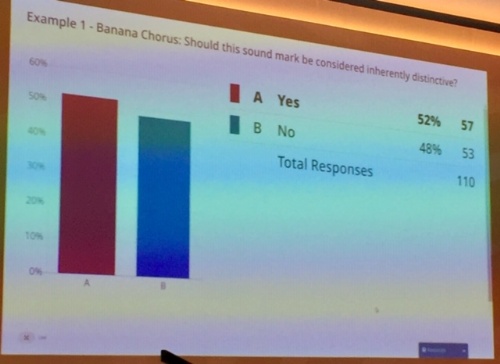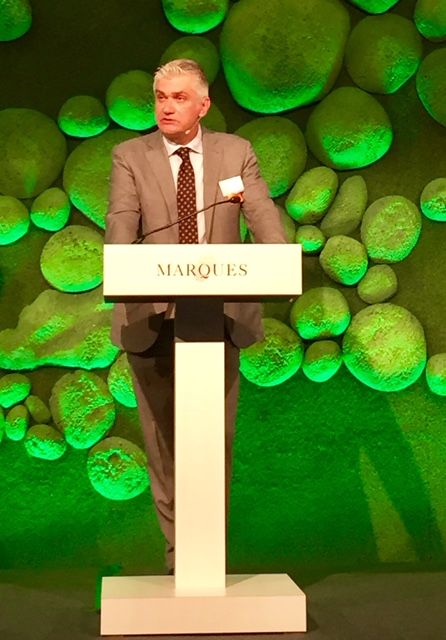Now in its twelfth year, Class 46 is dedicated to European trade mark law and practice. This weblog is written by a team of enthusiasts who want to spread the word and share their thoughts with others.
Click here subscribe for free.
Who we all are...
Latest trends on non-traditional marks – Annual Conference part 7
 Annual Conference delegates were divided over the registrability of three examples of sound marks, in interactive votes carried out during part 7 of this year’s Annual Conference. The votes suggested that roughly half of the audience believed each of the marks (for a banana jingle, a tune with the words “Premium Quality” and the same tune with no words) were inherently distinctive, illustrating the challenges examiners face when presented with applications for these types of marks.
Annual Conference delegates were divided over the registrability of three examples of sound marks, in interactive votes carried out during part 7 of this year’s Annual Conference. The votes suggested that roughly half of the audience believed each of the marks (for a banana jingle, a tune with the words “Premium Quality” and the same tune with no words) were inherently distinctive, illustrating the challenges examiners face when presented with applications for these types of marks.
The session concentrated on the registration of non-traditional marks, following the changes introduced in the past two years by the Trade Mark Regulation and Directive. Dimitris Botis, Deputy Director of ICLAD at EUIPO said the Office has been monitoring filing trends and issues that have arisen since the new Regulation was implemented. “The Guidance in Article 3 of the Implementing Regulation is a good thing for legal certainty,” he said.
 The number of applications for non-traditional marks is still small. Only around 1,400 out of nearly 300,000 applications filed since 1 October 2017 are non-traditional marks, including:
The number of applications for non-traditional marks is still small. Only around 1,400 out of nearly 300,000 applications filed since 1 October 2017 are non-traditional marks, including:
- 66 sound marks (of which 34 have been registered so far). Reasons for refusal under Article 7(1)(b) include being too long (39 seconds) and complex, being perceived as a mere burst engine noise and being too short, abstract and commonplace. The Board of Appeal has upheld a rejection of the sound of an effervescent drink being opened in its first decision on a sound mark under the new Regulation. Accepted sound applications include the Barca chant, the Fratelli tune and a short jingle for furniture. “We are continuously monitoring how examiners react to the new challenges and any difficulties they have in applying the Guidelines in a consistent manner,” said Dimitris.
- 64 motion marks (29 registered). Reasons given for refusal include being too closely related to the goods or their function (for hand gestures), being perceived as an instruction and having nothing particularly memorable other than showing a chart (this case has been appealed). However, some gesture marks have been registered where the gesture is not directly connected with the goods or services.
- 31 multimedia marks (17 registered). Marks that are purely promotional have been rejected but some simple and complex videos have been found to be distinctive.
- 3 hologram marks (2 registered).
- 19 other marks (9 registered). An application for metal elevator ropes was rejected.
There have been a number of oppositions filed against motion marks, all of which are at an early stage.
Dimitris also summarised recent relevant case law from the CJEU and EU General Court, including the Enercon, Hartwall, Textilis and Red Bull cases.
Regarding certification marks, there have been 226 applications, and 45 registered. There have been 72 objections based on formalities, most of which can easily be overcome, said Dimitris. But he added that there is a lack of harmonisation in the EU, as member states have the option to provide certification marks, and follow different practices. This creates problems when certification marks with geographical terms are cited as earlier rights. There are five cases on certification and collective marks pending before the courts.
 Further guidance on non-traditional marks will come from Convergence Programme 11, which MARQUES has been involved in as a user association. “There are a lot of borderline cases,” said Jana Bogatz of D Young & Co LLP, “and we need to find answers that work for all the offices with their different approaches.”
Further guidance on non-traditional marks will come from Convergence Programme 11, which MARQUES has been involved in as a user association. “There are a lot of borderline cases,” said Jana Bogatz of D Young & Co LLP, “and we need to find answers that work for all the offices with their different approaches.”
Petra Goldenbaum of CMS Hasche Sigle provided an update on the implementation of the Trade Mark Directive in EU Member States, and Roland Mallinson of Taylor Wessing summarised the latest Brexit developments, saying it was hoped that the UK would follow CP11 even in the event of a hard Brexit: “We don’t anticipate immediate divergence, but there is the possibility that the UK judges will take a different view of shapes and colours.” The panel was moderated by Robert Guthrie of Osborne Clarke.
Posted by: Blog Administrator @ 11.21Tags: Annual Conference, EUIPO, non-traditional marks, CP11,


 Sharing on Social Media? Use the link below...
Sharing on Social Media? Use the link below...Perm-A-Link: https://www.marques.org/blogs/class46?XID=BHA4786

